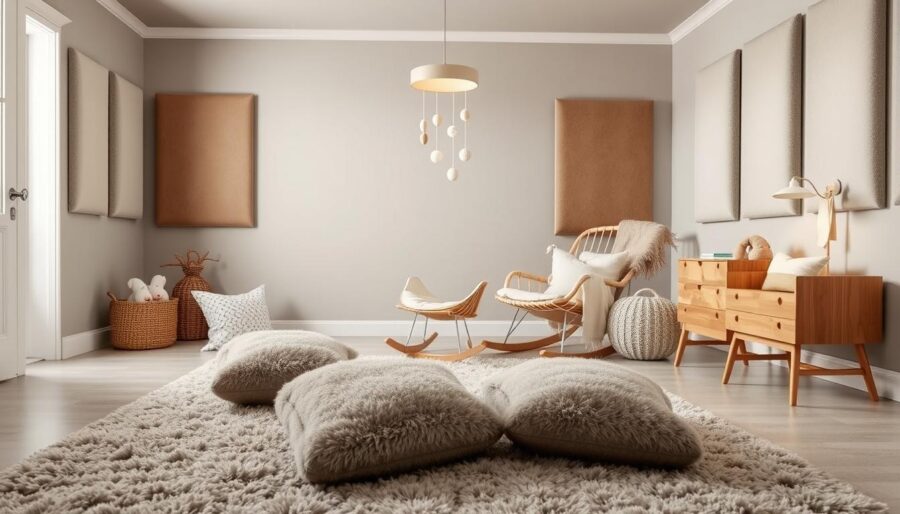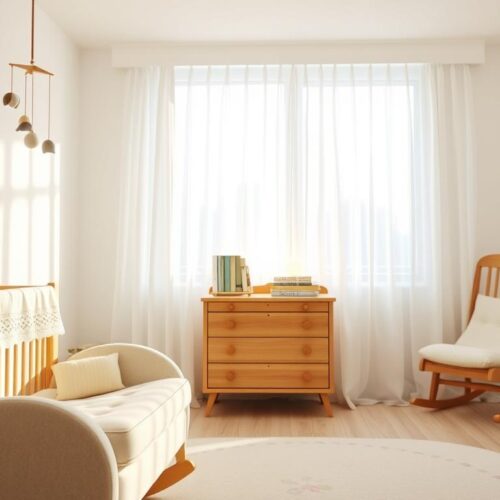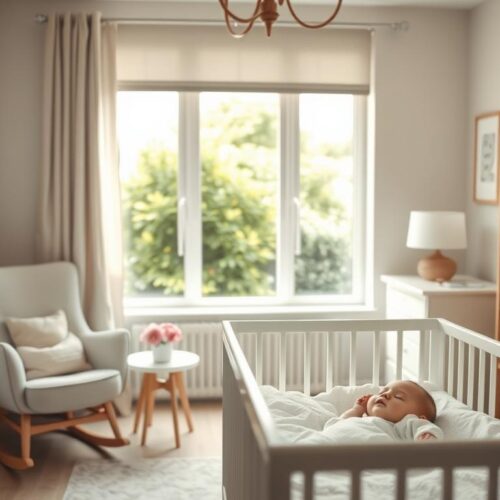Making your baby’s room calm is about more than picking cute decorations. It’s also key to manage sounds well. By adding acoustic decor, you create a quiet space. This helps both you and your baby sleep better. We’ll show you how to use soundproof designs and peaceful sounds to make the room look and feel nice.
Introduction to Acoustic Nursery Decor
Creating a calm space for your baby is more than color and furniture choices. It’s about using acoustic nursery decor principles for sound absorption. This reduces noise and makes the room peaceful. Let’s explore how to lessen echoes and reverberations in the nursery.
Think about using soft materials for newborn room ideas. Acoustic panels, thick curtains, and soft rugs help control sound. These items don’t just help with sound; they make the room cozy. They aim to keep noise low so your baby can sleep well.
To better the nursery’s sound, use sound-dampening materials and designs. Soft chairs and fabric on walls absorb noise well. Adding plush toys and soft mats also helps. These improve the nursery’s sound quality.
Applying these ideas creates a baby-safe haven that looks and sounds great. The right accessories and designs make the nursery quiet and peaceful for your baby.
Why Acoustics Are Important in a Nursery
Creating a calm space for your baby involves more than just sight. It includes the sounds around them. Proper acoustics in a nursery create a peaceful sleep space. Soft, steady sounds help babies sleep better and boost their well-being.
Experts in child care show that sound levels and quality affect how a baby sleeps. The American Academy of Pediatrics found that soft decor and gentle noise lead to better sleep for infants. This proves how crucial a sound-friendly environment is.
A quiet sleep place helps your baby reach deep sleep stages. These stages are vital for their growth. Also, a calm atmosphere can decrease sudden wake-ups and help babies reach important growth stages.
When setting up your nursery, include things that absorb and soften sounds. Items like soft fabrics, thick rugs, and acoustic panels make it look good and keep it quiet. These things help create a serene spot for your baby to grow.
Choosing the Right Materials for Sound Absorption
Creating a calm space for your baby starts with picking the right acoustic materials. Quality materials that soak up sound really make the nursery peaceful. It’s also key to think about the environment and choose eco-friendly options.
Wool is a top choice for its great sound absorption. It lessens noise and makes the room quieter. Plus, wool is natural, sustainable, and safe, perfect for eco-friendly nursery decor. Adding wool in things like rugs, curtains, and wall panels can really improve how your baby’s room sounds.
Acoustic foam is another good choice. It’s made to catch sound waves and comes in many shapes and sizes to fit your decor. These foams are safe and non-toxic, making them good for a baby’s room. Look for foams with low VOC emissions to keep the air quality healthy.
| Material | Sound Absorption | Sustainability | Safety |
|---|---|---|---|
| Wool | High | Natural and Renewable | Non-Toxic |
| Acoustic Foam | High | Varies by Brand | Varies by Brand |
Choosing the right eco-friendly nursery decor and safe materials makes a calm, safe space. Whether you go for natural wool or acoustic foams, these choices can make your baby’s nursery a quiet haven.
Incorporating Acoustic Nursery Decor
Designing a modern baby nursery means blending looks with usefulness, especially with decor that sounds great too. You can do this using nursery wall art that’s also a sound-absorbing panel. These panels come in many styles, so you keep the room looking good while also controlling the sound.
Soft materials help reduce noise in the nursery too. Add plush rugs, soft furniture, and heavy curtains. These not only make the room look cozy but also help keep it quiet, making a calm space for your baby.
- Acoustic Ceiling Tiles: Put these up to stop sound from bouncing down. This makes the room quieter.
- Fabric Wall Hangings: Hang up tapestries and quilts. They look great and soak up sound.
- Sound-Absorbing Cushions: Place these on seats to cut down on noise.
Check out these popular acoustic decor items and their perks:
| Decor Item | Sound Absorption | Aesthetic Value |
|---|---|---|
| Nursery Wall Art | High | Varies by design |
| Plush Rugs | Medium | Inviting and cozy |
| Thick Curtains | Medium | Elegant and functional |
| Fabric Wall Hangings | High | Artistic and colorful |
| Acoustic Ceiling Tiles | High | Typically neutral |
By carefully choosing these items, you can create a beautiful and sound-friendly nursery. It will be a peaceful place for your baby.
Using Rugs and Carpets for Better Acoustics
Using thick rugs and carpets in nursery rooms helps a lot with sound. They make the environment peaceful, perfect for sleep. Putting in soft nursery flooring cuts down on noise. It absorbs sound, making the room quiet and cozy for your baby.
Dense materials are key for sound-absorbing rugs. High-pile or shaggy rugs work well to soften sounds, limiting echo. Wool and nylon blends are great choices. They’re tough and good at soaking up sound.
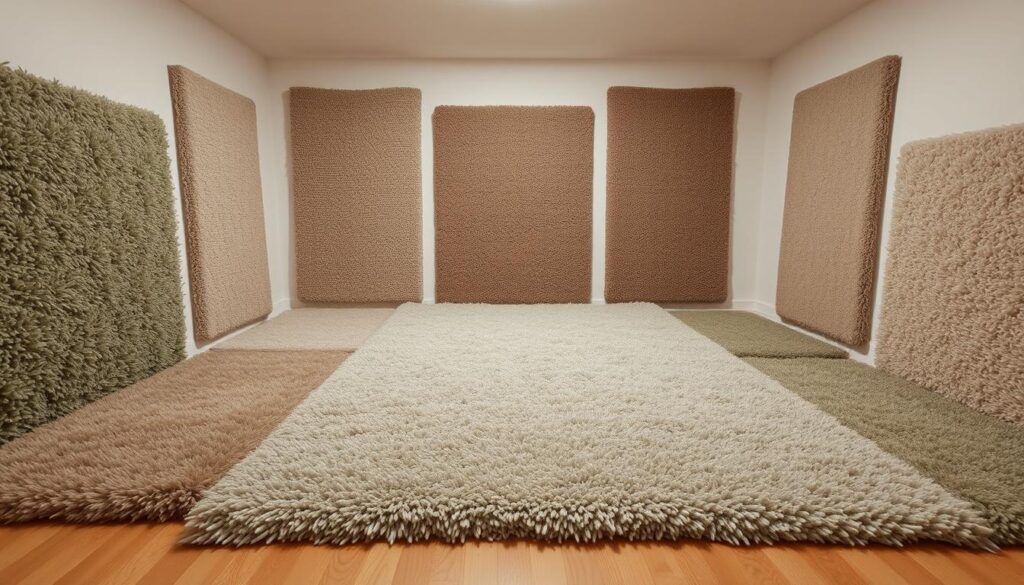
When picking out rugs, think about the weave. Loop and cut-pile styles have different sound dampening effects. Denser weaves do the best job. Here’s a comparison to help you decide:
| Material | Noise Reduction | Durability |
|---|---|---|
| Wool | High | High |
| Nylon Blend | Medium | Very High |
| Cotton | Low | Medium |
Getting good quality soft nursery flooring does more than look nice. It makes a calm space that helps kids rest well, which is important for their growth.
Soundproofing Windows and Doors
To make a nursery peaceful, focus on windows and doors. Good soundproofing cuts down outside noise. This helps your baby sleep well.
Using heavy drapes is a simple way to lessen noise. These thick curtains block outside sound. Make sure they go from the ceiling to the floor.
Installing special seals around windows and doors is smart too. These seals stop noise from getting in. Weatherstripping is also great for keeping noise out.
For a lasting fix, think about double-glazed windows. They have two glass panes with a gap, which blocks noise well. Plus, they keep the nursery comfy all year.
Here’s a comparison of various noise reduction treatments:
| Soundproofing Solution | Effectiveness | Additional Benefits |
|---|---|---|
| Heavy Drapes | High | Enhances room decor |
| Specialized Seals | Medium to High | Cost-effective |
| Double-Glazed Windows | Very High | Energy efficient |
Installing Acoustic Panels as Wall Art
Adding pretty acoustic panels to your baby’s room does two big things. It makes the room sound better and looks nicer. Turning sound-absorbing panels into custom art lets them fit right in with your nursery’s look. This makes the room quieter and more peaceful for your baby.
DIY-loving parents will find customizing these panels fun. You can cover the panels with pretty fabrics that go with your room’s colors or theme. The fabric not only makes the panels look good but keeps them working to reduce noise. This way, you get both style and function.
You can also blend the acoustic panels into your room’s design. You might arrange them in eye-catching patterns or mix them with other decor. For example, using panels in shapes or as part of a picture makes them art, not just soundproofing tools.
- Choose Your Fabric: Pick fabrics that match your nursery’s look. Go for patterns or colors that add to the room’s beauty.
- Customize Panel Shapes: Try out different shapes and setups to make a special visual effect.
- Install with Ease: Use easy-to-handle hardware to hang your custom art safely and securely.
Combining custom wall art with soundproofing makes your nursery not just prettier but also quieter. This creates a calming space for your baby.
Furniture Placement for Optimal Acoustics
Choosing the right spots for furniture in a nursery is key. This helps soak up sound and cut down on echoes. By placing furniture just right, you make the room better sounding. You also keep it cozy and cute for your baby.
Put the crib away from walls near noisy parts of the house. This cuts down on noise. If you can, placing the crib in a corner is smart. It uses the walls to dampen sound.
Adding soft walls or a big bookshelf full of books and soft toys against a wall helps a lot. This can soak up and lower noise.
You can also use big pieces like dressers on outside walls to block outside noise. Picking furniture that’s upholstered helps absorb sound better than wood or metal.
Here’s how different furniture pieces affect the room’s sound:
| Furniture Element | Positioning Tips | Acoustic Impact |
|---|---|---|
| Crib | Corner or away from exterior walls | Reduces direct noise impact |
| Bookshelves | Against external walls | Buffers external noise |
| Dressers | Along external walls | Additional sound barrier |
| Upholstered Chairs | Near the crib or windows | Absorbs ambient noise |
Using these tips for organizing a nursery can create a calmer space. With some planning, each piece of furniture can make the nursery sound-friendly. This leads to better sleep and comfort for your baby.
Incorporating Soft Textiles
Creating a cozy, quiet nursery is essential. Plush fabrics play a big part in this. They’re used in padded gliders, thick curtains, and plush toys. These items add comfort while absorbing sound. This helps make the nursery a peaceful place for your baby.
To improve the nursery’s quietness, add gentle textures. Use materials like cotton, velvet, and soft chenille. They not only block outside noise but also make the room feel welcoming.
Different plush fabrics can bring beauty and quiet to the nursery:
- Thick curtains: They significantly reduce outside noise.
- Padded gliders: These comfy seats help quiet the room.
- Plush toys: They lessen noise and add fun to the space.
It’s important to mix usefulness and style. By using plush fabrics and soft textures together, you improve the room’s quietness. You also make it a loving space for your baby.
Creating an Acoustic-Friendly Color Palette
When planning a nursery, think about looks and how the room works. Using calming colors can help control the room’s sound and feel. Picking the right colors for the nursery isn’t just about looks. It also makes the room quiet and nice to be in.
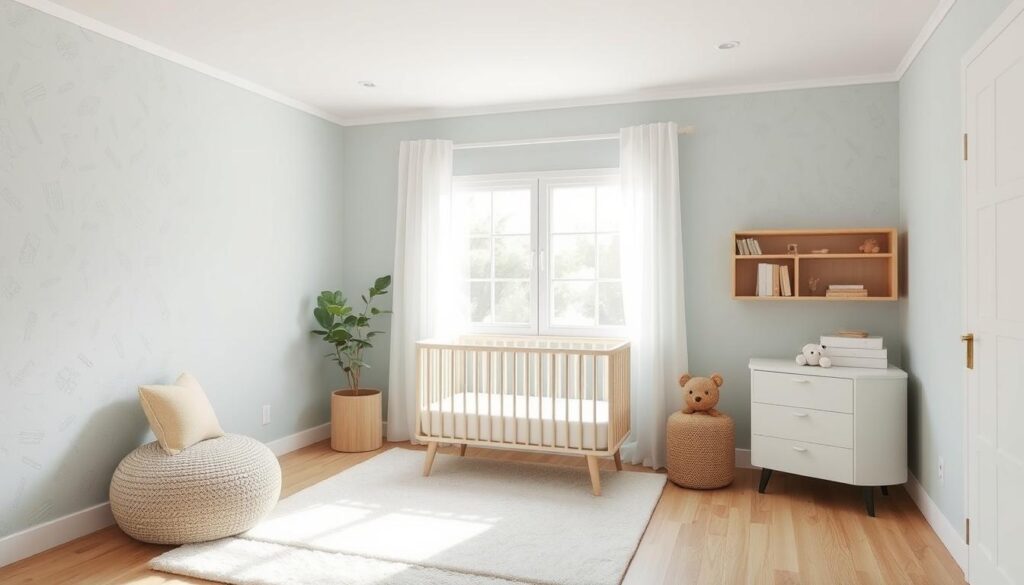
The colors you choose can change how space and sound feel. Soft, muted colors like pastel blues, gentle greens, and warm beiges are great choices. These colors make things feel calm and help babies relax. They also reduce noise from outside. By picking these colors, you make a quiet, sound-friendly space.
Here are some color suggestions to get you started:
- Pastel Blue: Calming and peaceful, it brings a sense of tranquility.
- Gentle Green: Makes you think of nature and relax.
- Warm Beige: A neutral, comfy color that helps with sleep.
These nursery paint ideas do more than just look good. They also create a cozy place for sound. By choosing these colors wisely, your nursery will be both pretty and practical. It will be a perfect spot for your baby.
Integrating Calming Nursery Decor
Creating a calm nursery is essential for the baby and their parents. Use calming design aspects that boost the room’s peace and sound quality.
Nature themes are perfect for a peaceful nursery feel. Add wall stickers of gentle trees, clouds, or light watercolors. These help make the room feel calm and peaceful.
Good lighting is key to a calm nursery. Use lights that you can dim to change the light’s strength and color. Lamps with dimmers, warm LEDs, and blackout curtains can help everyone sleep better.
Choose simple decor that’s easy on the eyes. Pick furniture with smooth shapes and light colors. Soft rugs, cushions, and curtains add beauty and improve the room’s sound, making it more tranquil.
Adding Gender-Neutral Nursery Decor
Parents now love gender-neutral nursery decor. It’s about making a space that works for any kid. Using calm colors like soft grays, whites, and greens can make both the baby and parents feel peaceful. This way, as the child grows, their room can easily change with them without a big redecorate.
There are many themes to pick from in gender-neutral decor. Designs with animals, trees, and stars can make a fun, soothing place. Themes about adventures or stories can spark your child’s imagination. These choices mean the nursery grows with your child as they show who they are.
Choose furniture and decorations that are both useful and stylish. Cribs that change into beds for toddlers are perfect here. Look for storage that fits right in and holds toys, books, and clothes well. This keeps the nursery tidy and calm.
Sensory elements, like soft fabrics, add to the decor. Pick curtains, pillows, and rugs in soft colors and textures. This makes the space warm and welcoming. Plus, different textures and materials are good for your child’s sensory learning.
Art and accessories make the nursery special. Pick items that show open values, like gender-neutral designs or hopeful quotes. Custom wall decals and growth charts can make it personal but keep to the theme. This makes the room special and flexible.
Soundproofing Ideas for Built-In Furniture
Soundproofing your baby’s nursery with custom furniture is a smart move. Built-in furniture like wardrobes or shelves saves space and helps control noise. Adding specific materials and designs can lower noise levels, making a peaceful space for your child.
Consider padded doors on closets or cabinets to absorb sound. Foam or upholstered panels are great for this. Design features like nooks within furniture can trap sound, adding beauty and function.
Below is a table that highlights some soundproofing features and their benefits for built-in furniture:
| Soundproofing Feature | Benefits |
|---|---|
| Padded Doors | Reduces noise transmission |
| Sound-Absorbing Panels | Enhances room acoustics |
| Recessed Nooks | Traps sound naturally |
| Thicker Shelving | Minimizes echo and reverberation |
These custom furniture ideas make your nursery quieter and more calming. A quiet nursery means better sleep for your baby and peace for your home.
Maintaining Acoustic Solutions Over Time
Keeping your nursery’s acoustics in top shape takes careful thought and regular upkeep. As your child gets older, you might need to tweak the original sound solutions.
Start by often checking on materials meant to soak up sound. Rugs, carpets, and textiles can wear out, making them less effective at keeping noise down. It’s important for nursery designs to let you swap out old parts easily, without messing up the room’s look. For example, you can buy high-quality acoustic panels that fit right in with your nursery’s style.
It’s also crucial to keep an eye on where your furniture and soundproofing stuff are placed. Moving things around can help keep the sound conditions just right as your kid’s needs change. Making these adjustments from time to time can also help if the noise from outside changes, ensuring the room stays quiet.
Moreover, think about improving your sound solutions, like adding more panels or using new materials that absorb sound better. Doing this not only keeps the nursery’s sound environment up to date but also makes sure it stays a quiet, calm place for your child to grow.
Here are simple steps to follow:
- Check and replace old rugs, carpets, and textiles regularly.
- Choose nursery designs that let you change acoustic parts easily.
- Move furniture as your child’s needs and sound control require.
- Keep your acoustic materials fresh to meet new needs and make use of the latest in sound control tech.
By doing these things, your nursery will keep being a quiet space that helps your child sleep and grow well.
| Item | Maintenance Frequency | Notes |
|---|---|---|
| Rugs and Carpets | Every 6-12 months | Check for wear and replace as needed |
| Acoustic Panels | Every 1-2 years | Assess condition and upgrade if necessary |
| Furniture Layout | As needed | Rearrange to adapt to changing needs |
| Soft Textiles | Every 6 months | Replace damaged fabrics |
Conclusion
When setting up a nursery, think about how sounds affect comfort. Good nursery design isn’t just about looks. Managing noise is key to a calm space. Choosing materials that soak up sound helps a lot. Also, using soft fabrics can make a big difference.
Adding rugs, carpets, and windows that block outside noise helps keep the room quiet. Place furniture wisely and use acoustic panels as decoration to add to the calm. Choosing calming colors and designs makes the room a peaceful spot. This way, the nursery becomes a peaceful place that helps everyone get along better.
Keep using these sound control methods to ensure the nursery stays a cozy retreat. A nursery designed with care for sound helps your child grow in a peaceful setting. It also gives you peace of mind. Making these smart choices shows how a quiet nursery is important for a joyful and healthy start to life.

